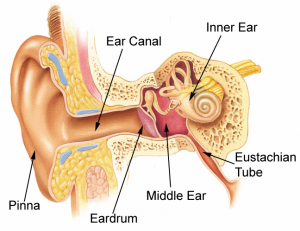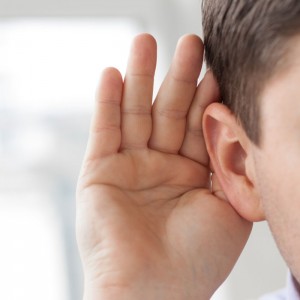How the Ear Works
The ear is made of 3 main parts: the outer ear, the middle ear, and the inner ear.

The outer ear consists of the part you can see (the Pinna), and the ear canal.
The middle ear is made up of the ear drum and the 3 little bones (ossicles) that conduct the sound through to the inner ear.
The inner ear is made up of the cochlea and auditory nerve. The cochlear is made up of thousands of tiny hair cells that pick up sound and move to stimulate the auditory nerve which sends the sound to the brain.
Hearing Loss
A loss of hearing is usually the result of damage or abnormality in one of the ear structures. Hearing loss is usually labelled according to the location of the problem in the ear. There are 3 main types of hearing loss: Conductive, Sensorineural, and Mixed hearing loss. In addition, someone may only have a hearing loss in one ear, known as unilateral hearing loss or Single Sided Deafness.
Conductive Hearing Loss
A conductive hearing loss is due to a blockage or damage in the outer or middle ear. The most common of these in children is fluid in the middle ear.
A buildup of fluid reduces the ability of the ear drum and ossicles from moving and conducting the sound through to the inner ear. Buildup of fluid is usually temporary, and resolves with time. However in some cases, the fluid needs to be drained from the middle ear by an Ear Nose and Throat surgeon, and grommets (ventilation tubes) are inserted. If your child suffers from ongoing middle ear effusion (fluid), contact us to discuss strategies to assist them in the classroom.
Sensorineural Hearing Loss
A sensorineural hearing loss is when there is damage or an abnormality of the inner ear. There are numerous factors that can cause this, including genetics, viruses, noise exposure or medication. It can be something you are born with, or something that happens suddenly, or gradually over time.
The more severe the level of hearing loss, the more likely the person will experience a degree of distortion of sound in addition to loss of audibility. Often the hearing is worse in the high frequencies. This means that someone will report that they can hear, but speech isn’t clear, or that the hearing difficulty experienced is worse in noisy situations such as restaurants.
Mixed Hearing Loss
This is a hearing loss that is due to problems both in the outer/middle ear and the inner ear. That is, the hearing loss is made up of both a conductive and sensorineural hearing loss.
Single Sided Deafness
Also known as unilateral hearing loss, single sided deafness is when someone has normal hearing in one ear and a hearing loss in the other ear. People with this condition are able to understand speech easily in quiet situations. However, they are likely to encounter difficulties understanding speech in noisy situations, especially from their impaired (“deaf”) side. People with single sided hearing loss are also likely to encounter difficulties telling where sounds are coming from.
What can be done to help single sided deafness?
Our Audiologist, Emma van Wanrooy has extensive experience assisting people with single sided hearing loss to adapt to their often sudden loss of hearing, and find the right device to help them achieve their listening goals. Devices that can help a person with single sided deafness include bone anchored hearing aids (eg/BAHA), CROS Hearing Aids, or a Cochlear Implant.
A CROS Hearing aid picks sound up from the “deaf” ear and sends it wirelessly across to the good ear. A Bone anchored hearing aid is a surgically implanted device that sends the sound across to the good ear through vibration of the skull and cochlea. Cochlear implants are inserted into the impaired cochlea and sound is transmitted electrically to the hearing nerve.
The best device for each person varies depending on what they want to achieve (e.g. localising sounds, hearing better in noise) and the cause of their hearing loss. Contact us for an assessment and consultation to find out what is best for your situation.
